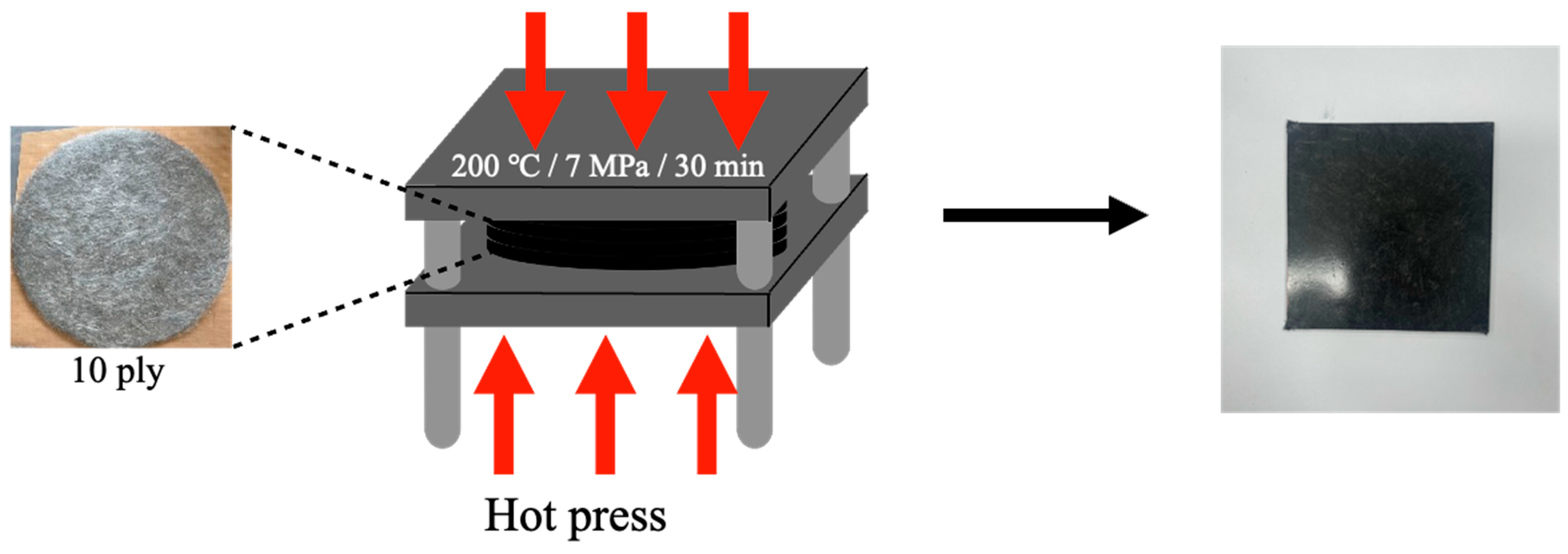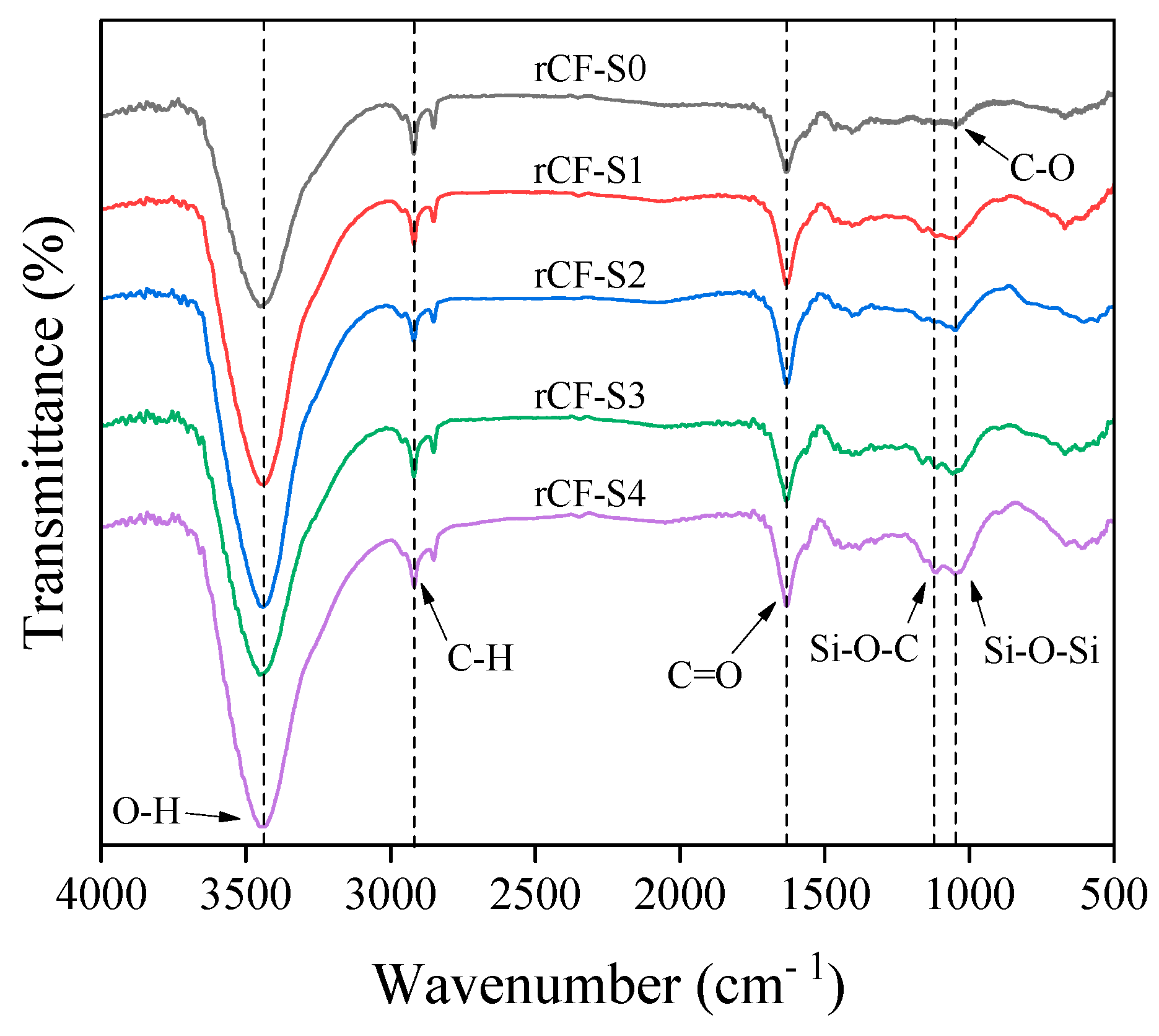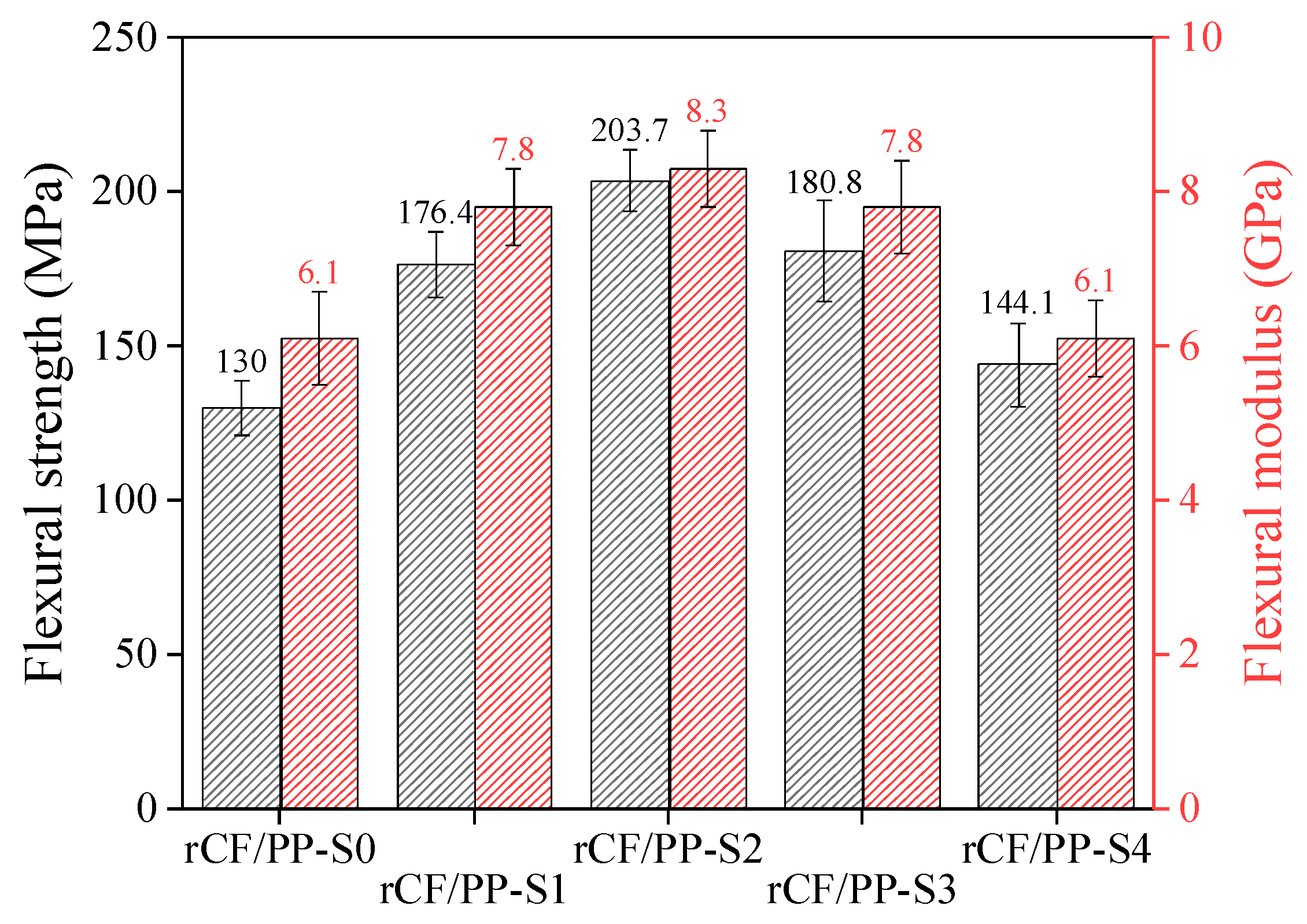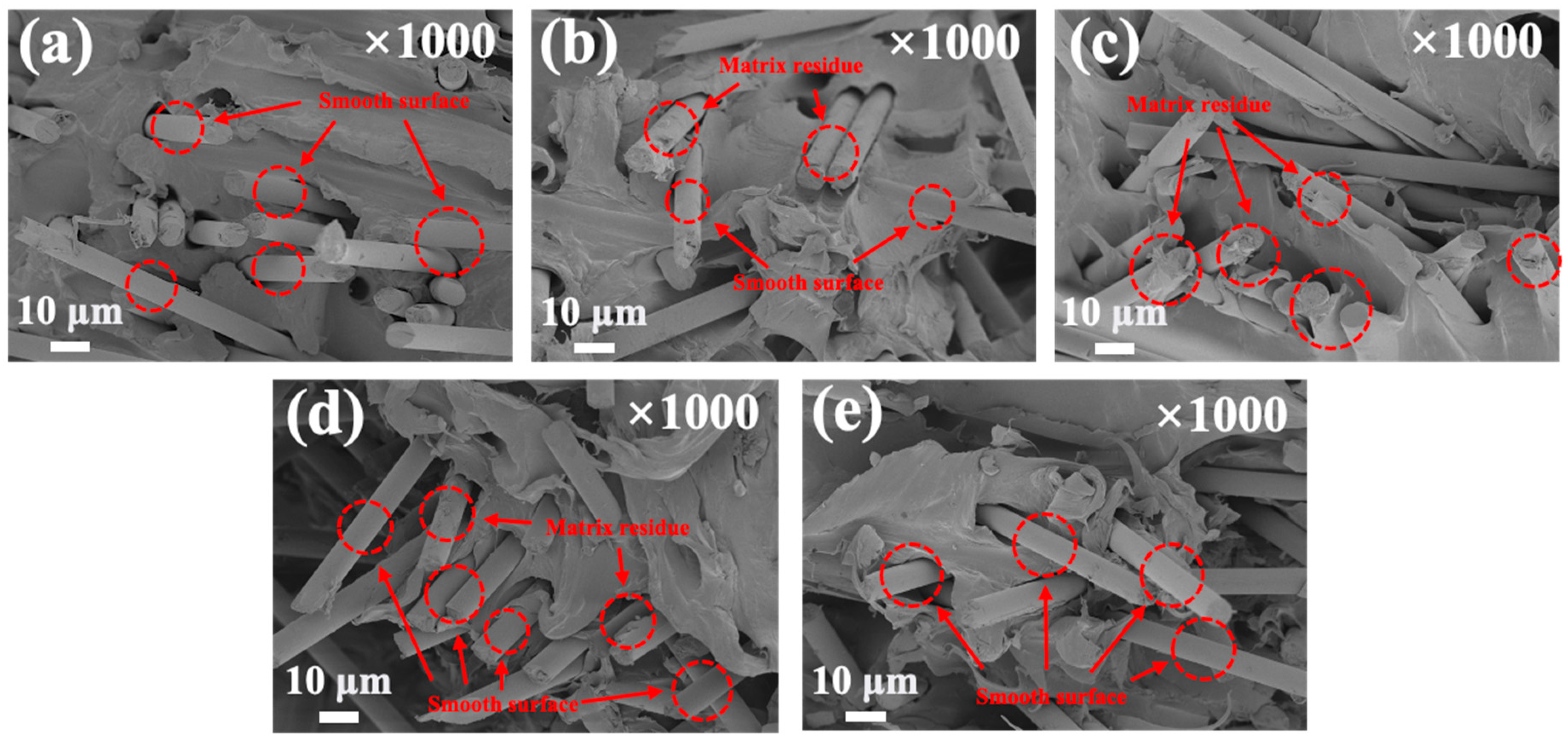Facile Enhancement of Mechanical Interfacial Strength of Recycled Carbon Fiber Web-Reinforced Polypropylene Composites via a Single-Step Silane Modification Process
Abstract
1. Introduction
2. Materials and Methods
2.1. Materials
2.2. Preparation of Silane-Treated Nonwoven Fabrics
2.3. Fabrication of Nonwoven Composites via Hot-Press Molding
2.4. Characterization
3. Results and Discussion
3.1. Characteristics of the Functionalized rCF Surface
3.2. Void Content and Fiber Density
3.3. Mechanical Interfacial Properties
3.4. SEM Observation of the Fracture Region
4. Conclusions
Author Contributions
Funding
Institutional Review Board Statement
Data Availability Statement
Conflicts of Interest
References
- Kim, K.W.; Kim, D.K.; Han, W.; Kim, B.J. Comparison of the characteristics of recycled carbon fibers/polymer composites by different recycling techniques. Molecules 2022, 27, 5663. [Google Scholar] [CrossRef]
- Lee, Y.M.; Kim, K.W.; Kim, B.J. High-Efficiency carbon fiber recovery method and characterization of carbon fiber-reinforced epoxy/4,4′-diaminodiphenyl sulfone composites. Polymers 2022, 14, 5304. [Google Scholar] [CrossRef] [PubMed]
- Geng, Y.; Wang, X.; Yao, J.; Niu, K.; Yang, C. Preparation of unsaturated self-emulsifying polyester sizing agents for improving interfacial and mechanical properties of carbon fiber/vinyl ester resin composites. Compos. Part A Appl. Sci. Manuf. 2024, 181, 108148. [Google Scholar] [CrossRef]
- Kang, S.H.; Kim, K.W.; Kim, B.J. Carbon fibers from high-density polyethylene using a hybrid cross-linking technique. Polymers 2021, 13, 2157. [Google Scholar] [CrossRef]
- Matsuda, S.; Koyano, S.; Oshima, K. Recycling of wet carbon fiber-reinforced plastic laminates by thermal decomposition coupled with electrical treatment. Compos. Part A Appl. Sci. Manuf. 2024, 178, 107991. [Google Scholar] [CrossRef]
- Uematsu, H.; Ishikawa, M.; Yamaguchi, A.; Sugihara, S.; Nishitsuji, S.; Nishimura, F.; Yamane, M.; Kawabe, K.; Ozaki, Y.; Tanoue, S. Enhancement of flexural properties of carbon fiber-reinforced polyamide 6 via oriented crystallization of polyamide 6 among carbon fibers. Compos. Part A Appl. Sci. Manuf. 2024, 176, 107837. [Google Scholar] [CrossRef]
- Wei, Y.; Hadigheh, S.A. Development of an innovative hybrid thermo-chemical recycling method for CFRP waste recovery. Compos. Part B Eng. 2023, 260, 110786. [Google Scholar] [CrossRef]
- Obunai, K.; Okubo, K. Mechanical characteristics of reclaimed carbon fibre under superheated steam atmosphere and its feasibility for remanufacturing CFRP/CFRTP. Compos. Part A Appl. Sci. Manuf. 2024, 176, 107843. [Google Scholar] [CrossRef]
- Jeong, J.S.; Kim, K.W.; An, K.H.; Kim, B.J. Fast recovery process of carbon fibers from waste carbon fibers-reinforced thermoset plastics. J. Environ. Manag. 2019, 247, 816–821. [Google Scholar] [CrossRef]
- Kim, H.H.; Kim, B.J. Recovery of carbon fibers from carbon fiber-reinforced epoxy-isophorone diamine composites via step thermolysis. Compos. Part B Eng. 2023, 260, 110757. [Google Scholar] [CrossRef]
- Pickering, S.J. Recycling technologies for thermoset composite materials—Current status. Compos. Part A Appl. Sci. Manuf. 2006, 37, 1206–1215. [Google Scholar] [CrossRef]
- Greco, A.; Maffezzoli, A.; Buccoliero, G.; Caretto, F.; Cornacchia, G. Thermal and chemical treatments of recycled carbon fibres for improved adhesion to polymeric matrix. J. Compos. Mater. 2013, 47, 369–377. [Google Scholar] [CrossRef]
- Ghossein, H.; Hassen, A.A.; Paquit, V.; Love, L.J.; Vaidya, U.K. Innovative method for enhancing carbon fibers dispersion in wet-laid nonwovens. Mater. Today Commun. 2018, 17, 100–108. [Google Scholar] [CrossRef]
- Wölling, J.; Schmieg, M.; Manis, F.; Drechsler, K. Nonwovens from recycled carbon fibres–Comparison of processing technologies. Procedia CIRP 2017, 66, 271–276. [Google Scholar] [CrossRef]
- Yan, X.; Wang, X.; Yang, J.; Zhao, G. Optimization of process parameters of recycled carbon fiber-reinforced thermoplastic prepared by the wet-laid hybrid nonwoven process. Text. Res. J. 2021, 91, 1565–1577. [Google Scholar] [CrossRef]
- Barnett, P.R.; Ghossein, H.K. A review of recent developments in composites made of recycled carbon fiber Textiles. Textiles 2021, 1, 433–465. [Google Scholar] [CrossRef]
- Sakthivel, S.; Melese, B.; Edae, A.; Abedom, F.; Mekonnen, S.; Solomon, E. Garment waste recycled cotton/polyester thermal and acoustic properties of air-laid nonwovens. Adv. Mater. Sci. Eng. 2020, 2020, 8304525. [Google Scholar] [CrossRef]
- Ayadi, M.; Dauchez, N.; Zouari, R.; Segovia, C.; Baffoun, A.; Msahli, S.; Nicolas, B. Natural fiber airlaid nonwoven panels for sound absorption: Measurement and prediction. SSRN 2023. [Google Scholar] [CrossRef]
- Manis, F.; Stegschuster, G.; Wölling, J.; Schlichter, S. Influences on textile and mechanical properties of recycled carbon fiber nonwovens produced by carding. J. Compos. Sci. 2021, 5, 209. [Google Scholar] [CrossRef]
- Pakdel, E.; Kashi, S.; Baum, T.; Usman, K.A.S.; Razal, J.M.; Varley, R.; Wang, X. Carbon fibre waste recycling into hybrid nonwovens for electromagnetic interference shielding and sound absorption. J. Clean. Prod. 2021, 315, 128196. [Google Scholar] [CrossRef]
- Xiao, B.; Zaima, T.; Shindo, K.; Kohira, T.; Morisawa, J.; Wan, Y.; Yin, G.; Ohsawa, I.; Takahashi, J. Characterization and elastic property modeling of discontinuous carbon fiber reinforced thermoplastics prepared by a carding and stretching system using treated carbon fibers. Compos. Part A Appl. Sci. Manuf. 2019, 126, 105598. [Google Scholar] [CrossRef]
- Jayachandran, A. Fundamentals of Fiber Dispersion in Water; North Carolina State University: Raleigh, NC, USA, 2001. [Google Scholar]
- Caba, A.C.; Loos, A.C.; Batra, R.C. Fiber-fiber interactions in carbon mat thermoplastics. Compos. Part A Appl. Sci. Manuf. 2007, 38, 469–483. [Google Scholar] [CrossRef]
- Tang, L.G.; Kardos, J.L. A review of methods for improving the interfacial adhesion between carbon fiber and polymer matrix. Polym. Compos. 1997, 18, 100–113. [Google Scholar] [CrossRef]
- Zhang, M.; Cheng, C.; Guo, C.; Jin, L.; Liu, L.; Li, M.; Shang, L.; Liu, Y.; Ao, Y. Co-depositing bio-inspired tannic acid-aminopropyltriethoxysilane coating onto carbon fiber for excellent interfacial adhesion of epoxy composites. Compos. Sci. Technol. 2021, 204, 108639. [Google Scholar] [CrossRef]
- Martínez-Landeros, V.H.; Vargas-Islas, S.Y.; Cruz-González, C.E.; Barrera, S.; Mourtazov, K.; Ramírez-Bon, R. Studies on the influence of surface treatment type, in the effectiveness of structural adhesive bonding, for carbon fiber reinforced composites. J. Manuf. Process. 2019, 39, 160–166. [Google Scholar] [CrossRef]
- Guo, Y.; Li, Y.; Wang, S.; Liu, Z.X.; Cai, B.; Wang, P.C. Effect of silane treatment on adhesion of adhesive-bonded carbon fiber reinforced nylon 6 composite. Int. J. Adhes. Adhes. 2019, 91, 102–115. [Google Scholar] [CrossRef]
- Yu, J.; Meng, L.; Fan, D.; Zhang, C.; Yu, F.; Huang, Y. The oxidation of carbon fibers through K2S2O8/AgNO3 system that preserves fiber tensile strength. Compos. Part B Eng. 2014, 60, 261–267. [Google Scholar] [CrossRef]
- Xu, Z.; Chen, L.; Huang, Y.; Li, J.; Wu, X.; Li, X.; Jiao, Y. Wettability of carbon fibers modified by acrylic acid and interface properties of carbon fiber/epoxy. Eur. Polym. J. 2008, 44, 494–503. [Google Scholar] [CrossRef]
- Ishifune, M.; Suzuki, R.; Mima, Y.; Uchida, K.; Yamashita, N.; Kashimura, S. Novel electrochemical surface modification method of carbon fiber and its utilization to the preparation of functional electrode. Electrochim. Acta 2005, 51, 14–22. [Google Scholar] [CrossRef]
- Qian, X.; Zhang, Y.G.; Wang, X.F.; Heng, Y.J.; Zhi, J.H. Effect of carbon fiber surface functionality on the moisture absorption behavior of carbon fiber/epoxy resin composites. Surf. Interface Anal. 2016, 48, 1271–1277. [Google Scholar] [CrossRef]
- Fu, Y.; Li, H.; Cao, W. Enhancing the interfacial properties of high-modulus carbon fiber reinforced polymer matrix composites via electrochemical surface oxidation and grafting. Compos. Part A Appl. Sci. Manuf. 2020, 130, 105719. [Google Scholar] [CrossRef]
- Yan, C.; Zhu, Y.; Liu, D.; Xu, H.; Chen, G.; Chen, M.; Cai, G. Improving interfacial adhesion and mechanical properties of carbon fiber reinforced polyamide 6 composites with environment-friendly water-based sizing agent. Compos. Part B Eng. 2023, 258, 110675. [Google Scholar] [CrossRef]
- Wang, S.; Yang, Y.; Mu, Y.; Shi, J.; Cong, X.; Luan, J.; Wang, G. Synergy of electrochemical grafting and crosslinkable crystalline sizing agent to enhance the interfacial strength of carbon fiber/PEEK composites. Compos. Sci. Technol. 2021, 203, 108562. [Google Scholar] [CrossRef]
- Li, S.; Yang, C.; Yao, L.; Wu, B.; Lu, Y. Use a polyurethane sizing agent to improve the interfacial properties of carbon fiber-reinforced polyurethane composites. Carbon 2023, 209, 118028. [Google Scholar] [CrossRef]
- Williams, D.F.; Abel, M.L.; Grant, E.; Hrachova, J.; Watts, J.F. Flame treatment of polypropylene: A study by electron and ion spectroscopies. Int. J. Adhes. Adhes. 2015, 63, 26–33. [Google Scholar] [CrossRef]
- Dai, Z.; Zhang, B.; Shi, F.; Li, M.; Zhang, Z.; Gu, Y. Effect of heat treatment on carbon fiber surface properties and fibers/epoxy interfacial adhesion. Appl. Surf. Sci. 2011, 257, 8457–8461. [Google Scholar] [CrossRef]
- Ma, K.; Chen, P.; Wang, B.; Cui, G.; Xu, X. A study of the effect of oxygen plasma treatment on the interfacial properties of carbon fiber/epoxy composites. J. Appl. Polym. Sci. 2010, 118, 1606–1614. [Google Scholar] [CrossRef]
- Putra, A.E.E.; Renreng, I.; Arsyad, H.; Bakri, B. Investigating the effects of liquid-plasma treatment on tensile strength of coir fibers and interfacial fiber-matrix adhesion of composites. Compos. Part B Eng. 2020, 183, 107722. [Google Scholar] [CrossRef]
- Lee, Y.M.; You, J.; Kim, M.; Kim, T.A.; Lee, S.S.; Bang, J.; Park, J.H. Highly improved interfacial affinity in carbon fiber-reinforced polymer composites via oxygen and nitrogen plasma-assisted mechanochemistry. Compos. Part B Eng. 2019, 165, 725–732. [Google Scholar] [CrossRef]
- Kim, D.K.; Kang, S.H.; Han, W.; Kim, K.W.; Kim, B.J. Facile method to enhance the mechanical interfacial strength between carbon fibers and polyamide 6 using modified silane coupling agents. Carbon Lett. 2022, 32, 1463–1472. [Google Scholar] [CrossRef]
- Yao, S.S.; Lee, S.Y.; Li, H.L.; Jin, F.L.; Park, S.J. Enhanced thermal conductivity of carbon fibers/silanized graphene/epoxy matrix composites. Carbon Lett. 2024, 34, 647–655. [Google Scholar] [CrossRef]
- Hu, J.; Li, F.; Wang, B.; Zhang, H.; Ji, C.; Wang, S.; Zhou, Z. A two-step combination strategy for significantly enhancing the interfacial adhesion of CF/PPS composites: The liquid-phase oxidation followed by grafting of silane coupling agent. Compos. Part B Eng. 2020, 191, 107966. [Google Scholar] [CrossRef]
- Xie, Y.; Hill, C.A.S.; Xiao, Z.; Militz, H.; Mai, C. Silane coupling agents used for natural fiber/polymer composites: A review. Compos. Part A Appl. Sci. Manuf. 2010, 41, 806–819. [Google Scholar] [CrossRef]
- Yuan, H.; Wang, C.; Zhang, S.; Lin, X. Erratum: Effect of surface modification on carbon fiber and its reinforced phenolic matrix composite (Applied Surface Science (2012) 259 (288–293)). Appl. Surf. Sci. 2013, 264, 902. [Google Scholar] [CrossRef]
- Kim, D.K.; Han, W.; Kim, K.W.; Kim, B.J. Enhanced interfacial properties of carbon fiber/maleic anhydride-grafted polypropylene composites via two-step surface treatment: Electrochemical oxidation and silane treatment. Polymers 2023, 15, 3784. [Google Scholar] [CrossRef] [PubMed]
- Wen, Z.; Xu, C.; Qian, X.; Zhang, Y.; Wang, X.; Song, S.; Dai, M.; Zhang, C. A two-step carbon fiber surface treatment and its effect on the interfacial properties of CF/EP composites: The electrochemical oxidation followed by grafting of silane coupling agent. Appl. Surf. Sci. 2019, 486, 546–554. [Google Scholar] [CrossRef]
- Kim, K.W.; Jeong, J.S.; An, K.H.; Kim, B.J. A study on the microstructural changes and mechanical behaviors of carbon fibers induced by optimized electrochemical etching. Compos. Part B Eng. 2019, 165, 764–771. [Google Scholar] [CrossRef]
- Zheng, N.; He, J.; Zhao, D.; Huang, Y.; Gao, J.; Mai, Y.W. Improvement of atomic oxygen erosion resistance of carbon fiber and carbon fiber/epoxy composite interface with a silane coupling agent. Mater. Des. 2016, 109, 171–178. [Google Scholar] [CrossRef]
- Lu, S.; Zhang, B.; Niu, J.; Yang, C.; Sun, C.; Wang, L.; Li, D. Effect of fiber content on mechanical properties of carbon fiber-reinforced polyether-ether-ketone composites prepared using screw extrusion-based online mixing 3D printing. Addit. Manuf. 2024, 80, 103976. [Google Scholar] [CrossRef]
- Unterweger, C.; Duchoslav, J.; Stifter, D.; Fürst, C. Characterization of carbon fiber surfaces and their impact on the mechanical properties of short carbon fiber reinforced polypropylene composites. Compos. Sci. Technol. 2015, 108, 41–47. [Google Scholar] [CrossRef]
- Santos, M.E.B.; Morgado, G.F.M.; Santos, L.F.P.; Backes, E.H.; Marini, J.; Montagna, L.S.; Passador, F.R. Mechanical recycling process: An alternative for CF/PA6 composite waste from the automotive industry. ACS Sustain. Resour. Manag. 2024, 1, 3–12. [Google Scholar] [CrossRef]
- Hendlmeier, A.; Simon, Ž.; Chutani, A.; Henderson, L.C. Generating short carbon fiber polyamide-6 composites from continuous carbon fiber—A preliminary examination of surface treatment and sizing effects. Compos. Part A Appl. Sci. Manuf. 2020, 138, 106058. [Google Scholar] [CrossRef]
- Kim, H.H.; Han, W.; Lee, H.S.; Min, B.G.; Kim, B.J. Preparation and characterization of silicon nitride (Si–N)-coated carbon fibers and their effects on thermal properties in composites. Mater. Sci. Eng. B 2015, 200, 132–138. [Google Scholar] [CrossRef]
- Zhang, X.; Xu, H.; Fan, X. Grafting of amine-capped cross-linked polyphosphazenes onto carbon fiber surfaces: A novel coupling agent for fiber reinforced composites. RSC Adv. 2014, 4, 12198–12205. [Google Scholar] [CrossRef]
- Yang, J.; Xiao, J.; Zeng, J.; Bian, L.; Peng, C.; Yang, F. Matrix modification with silane coupling agent for carbon fiber reinforced epoxy composites. Fibers Polym. 2013, 14, 759–766. [Google Scholar] [CrossRef]










| Fiber | Composite | |||||
|---|---|---|---|---|---|---|
| Sample | Silane Content (wt%) | Sample | P (MPa) | T (°C) | Holding Time (min) | Natural Cooling (°C) |
| rCF-S0 | - | rCF/PP-S0 | 7 | 200 | 30 | 40 |
| rCF-S1 | 1 | rCF/PP-S1 | ||||
| rCF-S2 | 2 | rCF/PP-S2 | ||||
| rCF-S3 | 3 | rCF/PP-S3 | ||||
| rCF-S4 | 4 | rCF/PP-S4 | ||||
| Sample | Theoretical Density (g/cm3) | Density (g/cm3) | Void Content (%) |
|---|---|---|---|
| rCF/PP-S0 | 1.054 | 0.790 | 24.739 |
| rCF/PP-S1 | 0.812 | 22.699 | |
| rCF/PP-S2 | 0.839 | 20.124 | |
| rCF/PP-S3 | 0.852 | 18.830 | |
| rCF/PP-S4 | 0.882 | 16.027 |
Disclaimer/Publisher’s Note: The statements, opinions and data contained in all publications are solely those of the individual author(s) and contributor(s) and not of MDPI and/or the editor(s). MDPI and/or the editor(s) disclaim responsibility for any injury to people or property resulting from any ideas, methods, instructions or products referred to in the content. |
© 2025 by the authors. Licensee MDPI, Basel, Switzerland. This article is an open access article distributed under the terms and conditions of the Creative Commons Attribution (CC BY) license (https://creativecommons.org/licenses/by/4.0/).
Share and Cite
Song, Y.-J.; Kim, D.-K.; Han, W.; Choi, S.-H.; Chung, D.-C.; Kim, K.-W.; Kim, B.-J. Facile Enhancement of Mechanical Interfacial Strength of Recycled Carbon Fiber Web-Reinforced Polypropylene Composites via a Single-Step Silane Modification Process. Polymers 2025, 17, 483. https://doi.org/10.3390/polym17040483
Song Y-J, Kim D-K, Han W, Choi S-H, Chung D-C, Kim K-W, Kim B-J. Facile Enhancement of Mechanical Interfacial Strength of Recycled Carbon Fiber Web-Reinforced Polypropylene Composites via a Single-Step Silane Modification Process. Polymers. 2025; 17(4):483. https://doi.org/10.3390/polym17040483
Chicago/Turabian StyleSong, Yeo-Jun, Dong-Kyu Kim, Woong Han, Sun-Ho Choi, Dong-Chul Chung, Kwan-Woo Kim, and Byung-Joo Kim. 2025. "Facile Enhancement of Mechanical Interfacial Strength of Recycled Carbon Fiber Web-Reinforced Polypropylene Composites via a Single-Step Silane Modification Process" Polymers 17, no. 4: 483. https://doi.org/10.3390/polym17040483
APA StyleSong, Y.-J., Kim, D.-K., Han, W., Choi, S.-H., Chung, D.-C., Kim, K.-W., & Kim, B.-J. (2025). Facile Enhancement of Mechanical Interfacial Strength of Recycled Carbon Fiber Web-Reinforced Polypropylene Composites via a Single-Step Silane Modification Process. Polymers, 17(4), 483. https://doi.org/10.3390/polym17040483








